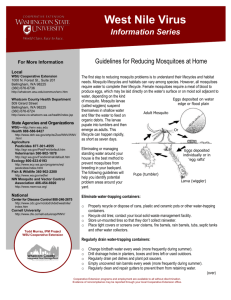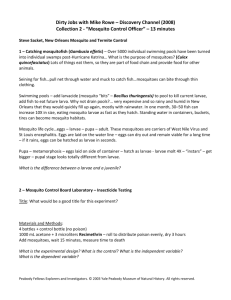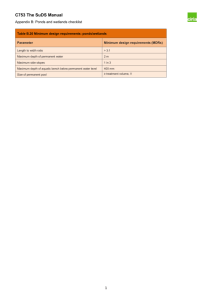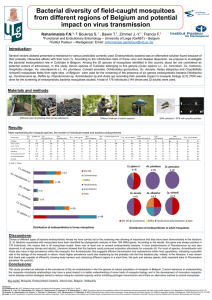The issue of mosquitoes and water has a long history of discussion
advertisement
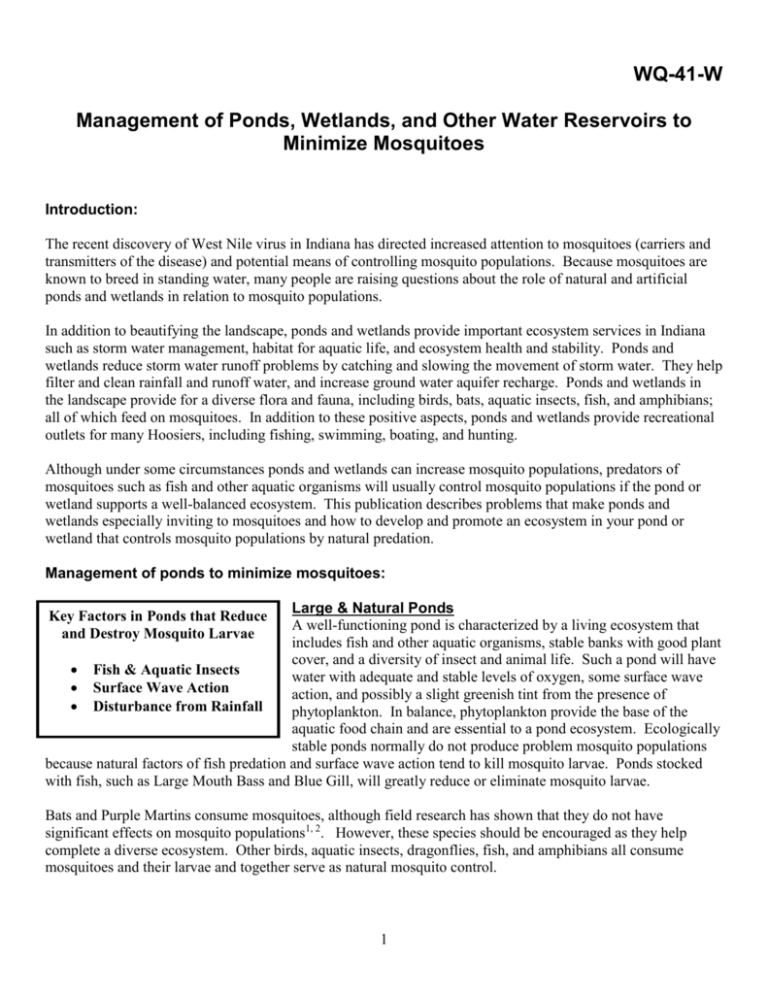
WQ-41-W Management of Ponds, Wetlands, and Other Water Reservoirs to Minimize Mosquitoes Introduction: The recent discovery of West Nile virus in Indiana has directed increased attention to mosquitoes (carriers and transmitters of the disease) and potential means of controlling mosquito populations. Because mosquitoes are known to breed in standing water, many people are raising questions about the role of natural and artificial ponds and wetlands in relation to mosquito populations. In addition to beautifying the landscape, ponds and wetlands provide important ecosystem services in Indiana such as storm water management, habitat for aquatic life, and ecosystem health and stability. Ponds and wetlands reduce storm water runoff problems by catching and slowing the movement of storm water. They help filter and clean rainfall and runoff water, and increase ground water aquifer recharge. Ponds and wetlands in the landscape provide for a diverse flora and fauna, including birds, bats, aquatic insects, fish, and amphibians; all of which feed on mosquitoes. In addition to these positive aspects, ponds and wetlands provide recreational outlets for many Hoosiers, including fishing, swimming, boating, and hunting. Although under some circumstances ponds and wetlands can increase mosquito populations, predators of mosquitoes such as fish and other aquatic organisms will usually control mosquito populations if the pond or wetland supports a well-balanced ecosystem. This publication describes problems that make ponds and wetlands especially inviting to mosquitoes and how to develop and promote an ecosystem in your pond or wetland that controls mosquito populations by natural predation. Management of ponds to minimize mosquitoes: Large & Natural Ponds A well-functioning pond is characterized by a living ecosystem that includes fish and other aquatic organisms, stable banks with good plant cover, and a diversity of insect and animal life. Such a pond will have Fish & Aquatic Insects water with adequate and stable levels of oxygen, some surface wave Surface Wave Action action, and possibly a slight greenish tint from the presence of Disturbance from Rainfall phytoplankton. In balance, phytoplankton provide the base of the aquatic food chain and are essential to a pond ecosystem. Ecologically stable ponds normally do not produce problem mosquito populations because natural factors of fish predation and surface wave action tend to kill mosquito larvae. Ponds stocked with fish, such as Large Mouth Bass and Blue Gill, will greatly reduce or eliminate mosquito larvae. Key Factors in Ponds that Reduce and Destroy Mosquito Larvae Bats and Purple Martins consume mosquitoes, although field research has shown that they do not have significant effects on mosquito populations1, 2. However, these species should be encouraged as they help complete a diverse ecosystem. Other birds, aquatic insects, dragonflies, fish, and amphibians all consume mosquitoes and their larvae and together serve as natural mosquito control. 1 Mosquito Prevention Checklist for Pond Owners Maintain high quality vegetative buffers around the pond Use top feeding minnows and other fish to reduce or eliminate mosquito larvae Use aeration to improve stagnant ponds Prevent excess nutrients and pollutants from entering the pond Do not spray chemicals or apply fertilizer near, uphill, or upwind from the pond Prevent livestock from entering the pond and degrading the banks of the pond Prevent ruts when mowing Keep grass clippings out of the pond Encourage patches of natural vegetation at pond edges to provide beneficial wildlife and insect habitat Avoid shallow ponds and basins without fish or aeration Employ chemical controls by a certified pesticide applicator only as a last resort In addition to fish, wave action or water movement on the pond surface is an important factor in reducing mosquito larvae survival rates. Natural ponds and most Indiana farm ponds will have adequate surface water movement and do not require additional aeration. In the case of stagnant ponds lacking water movement, or ponds lacking enough oxygen for fish survival, mechanical aerators can help improve the pond condition. Ponds receiving excess nutrients can favor algae blooms and submersed aquatic vegetation. This situation can lead to increased mosquito egg laying in these ponds and pools due to excess plant cover providing the larvae with protection from predators, wave action, and rainfall3. Mosquito larvae also feed on organic debris in water. These problem ponds need to be addressed by restoring the pond with aeration and stocking it with fish. For more information on pond aeration and restoring water movement contact one of the resource people listed at the end of this publication, or view the following web publication: http://agpublications.tamu.edu/pubs/efish/370fs.pdf. Avoid the use of fertilizer within at least a 50 foot radius of ponds since this will help prevent excess nutrients from entering the ponds. Make sure that high quality vegetative buffers are in place around ponds. This will slow or trap sediment, pesticides, and nutrients. Encouraging natural vegetation on the banks and shoreline of larger ponds may provide some adult mosquito habitat, however it also has many benefits for pond quality. Tall vegetation surrounding a pond makes it less attractive to geese. Large numbers of geese can degrade pond water quality and have also been implicated as vectors of West Nile virus4. In addition, natural vegetation surrounding large ponds provides habitat for predators of adult mosquitoes and their larvae. Types of Aquatic Vegetation Emergent – plants that are rooted in the silt and pond shoreline such as cattails. Rooted-Floating – plants that are rooted under water in shallow areas and have floating surface vegetation such as waterlily. Submersed – plants that have their roots under water in bottom sediments and grow up through the water such as pondweed. A balance must be struck between open water and aquatic vegetation. A good rule of thumb is to have 30% of the shallow area of the pond in rooted-floating and submersed Free-Floating – very small plants that float aquatic vegetation. These aquatic plants provide necessary on the surface such as duckweed. habitat for fish and other wildlife and should be protected. The side slope of ponds influences the presence of submersed and rooted-floating aquatic plants. For more information on pond side slope and construction see the contact list on page 6 under the section: “Assistance with pond and wetland restoration and management”. 2 For information on controlling invasive aquatic plants refer to the following Purdue Extension publications; Aquatic Plant Management WS-21 http://www.agcom.purdue.edu/AgCom/Pubs/WS/WS_21.pdf, Barley Straw for Algae Control APM-1-W http://www.btny.purdue.edu/Pubs/APM/APM-1-W.pdf , and Control of Duckweed and Watermeal APM-2-W http://www.btny.purdue.edu/Pubs/APM/APM-2-W.pdf . Small Backyard Water Gardens & Shallow Ponds Small or very shallow ponds are prone to mosquito problems if they lack fish, water movement, or have their edges or surfaces completely covered with aquatic plants. If a small pond becomes stagnant restore water movement with a fountain, waterfall, or other aerator and stock the pond with minnows. Top feeding minnows will provide effective mosquito control in small ponds. A small fish that has received a lot of media attention is the Mosquito fish (Gambusia affinis). They have been shown to be the most effective fish for mosquito control in ponds not connected to natural waterways5, 6. However, Mosquito fish do eat and affect habitat resources at varying levels and should not be considered for ponds connected with natural waterways7. As water temperature rises it holds less oxygen. This may have a deleterious effect on fish in small and shallow ponds during summer months. Providing afternoon shade from hot summer sun for small and shallow ponds can improve conditions for fish by helping to keep water temperature from rising beyond the capacity of fish to tolerate. Artificial aeration will also help improve oxygen levels in small ponds. If mosquitoes are a problem, mowing around small backyard or shallow ponds may be necessary in order to eliminate adult mosquito habitat. Clippings from mowed vegetation can cause problems if they end up in the pond since they add excess nutrients and provide additional food and protection for mosquito larvae8. Make sure that clippings are prevented from entering the pond. For more information on backyard water gardens view this web publication http://wildlife.tamu.edu/publications/TAEXPonds/789a.pdf. Storm Water Ponds & Infiltration Areas Ponds that have been built specifically for catching and holding storm water have important environmental benefits. When properly designed and managed these storm water ponds and infiltration areas should not become problem mosquito breeding habitat8. However, there are conditions under which these areas can encourage mosquitoes. When storm water holding ponds become nearly dry, vector mosquitoes may invade the ponds. Large fluctuations in water levels of storm water ponds can make the system ideal for floodwater mosquitoes. Monitor for mosquito larvae during periods when water levels remain low, or when water levels fluctuate frequently. Areas designed to infiltrate, rather than hold, storm water can also become potential mosquito breeding areas. If these infiltration areas remain wet for periods longer than 72 hours, floodwater mosquitoes are often the first to invade8. If poor management has resulted in grass cuttings or polluted runoff accumulating in these wet areas, vector mosquitoes can be found later in the summer season. Avoid placement of infiltration systems in areas where they are likely to remain wet for longer than 72 hours (e.g. where the water table is close to the surface). Storm water infiltration areas should be free of isolated depressions that could allow water to accumulate for longer periods. Mowing near infiltration areas should be done without producing ruts where water can collect, and grass clippings and debris should be removed regularly. Use of Chemical Products in Ponds to Control Mosquitoes Questions arise about the use of chemicals and other products for mosquito control. Due to a higher level of environmental and human health risk compared with natural mosquito control methods, chemical controls should be seen as a last resort. Chemicals for mosquito control are best left to certified pesticide applicators9. Before applying chemical controls, you should verify that the mosquito population in question is at risk for transmitting disease. For more information see the Purdue Extension publication E-52-W, Mosquito Control by Trained Personnel, http://www.entm.purdue.edu/Entomology/ext/targets/e-series/EseriesPDF/E-52.pdf 3 Wetlands and mosquitoes: Natural Wetlands Management practices that ensure healthy, functioning aquatic ecosystems are proven long-term and costeffective strategies for controlling mosquito populations. Contrary to popular belief, natural wetlands can reduce the population of mosquitoes compared with drained or degraded wetland areas. According to the Indiana Department of Natural Resources-Division of Fish & Wildlife, wetland restoration decreases mosquito populations in two ways: by providing healthy habitat for the natural enemies of mosquitoes, and by preventing or reducing flooding in non-wetland areas. The IDNR fact sheet, “Did you know? Healthy wetlands devour mosquitoes” (http://www.in.gov/dnr/fishwild/publications/inwetcon/hlywet.pdf), provides an example of one mosquito control project that documented a reduction of 90 percent in the mosquito population after restoring a 1,500 acre wetland area10. To be certain, all wetlands will have populations of mosquitoes varying with the degree of wetness and air temperature. During drought periods when water in some wetland areas may be reduced to small or shallow pools, mosquitoes can migrate and congregate in these smaller areas of wetness, though populations of flood water mosquitoes overall tend to decrease during drought periods 11, 12. However, in areas where wetlands have been drained mosquito populations thrive when these former wetland areas become inundated after rain storms10. Following rain, intermittent moist muddy or shallow stagnant water combined with an absence of predators of mosquitoes can allow the mosquito population to explode 10,11,12,13, including disease carrying mosquitoes that breed only in stagnant water 11. This type of flooding in non-wetland areas occurs more frequently after wetlands are drained and this creates the most serious nuisance mosquito problems in Indiana 10 . The Indiana Department of Natural Resources recommends restoring these wetland ecosystems10. For additional information on wetlands see the Purdue Extension publication Wetlands and Water Quality WQ-10 http://persephone.agcom.purdue.edu/AgCom/Pubs/WQ/WQ-10.html. Long-term commitment to wetland restoration also saves tax payers money on mosquito control. A study of a 548 acre marsh in 1969 on the U.S. east coast reported spending $16,000 to implement wetland restoration. Since that time the wetland has not needed any maintenance, cleaning, pesticides, or other costs. It was estimated that in a 25 year period since 1969 traditional insecticide methods would have cost $685,00010, 14, 15. Constructed Wetlands: “Artificial” wetlands are being constructed in Indiana to control and treat storm water and wastewater. Whenever possible, constructed wetlands that treat wastewater should be located away from residential areas and beyond the flight range of local disease carrying mosquitoes. Locating constructed wetlands in open areas where wind can produce waves in the wetland will disrupt mosquito development. Pollutant traps and sedimentation zones within the wetland should be managed to prevent blockages and pollutant buildup, as blockage can promote stagnant water. Maintaining water movement through the wetland is important for reducing mosquito populations. Riffle zones provide turbulence detrimental to mosquito larvae and also raise oxygen levels in the water. 4 Water reservoirs other than ponds and wetlands where mosquitoes may breed (Listed alphabetically) Basements with standing water Birdbaths Boats that have not been drained or covered Cans, jars, other open containers Clogged house roof gutters Culverts with stagnant water Ditches that hold stagnant water Drain outlets from air-conditioners Dripping outdoor faucets Flower pots Leaf-filled drains Leaking pipe joints Livestock water tanks Manure treatment lagoons Old cisterns Ornamental ponds Over-irrigated lawns and fields Saucers under potted plants Septic absorption fields (if soggy) Sewage treatment ponds Standing water in tire ruts and horse or livestock lots Storm water drain systems Street gutters, catch basins at road corners Stumps and tree holes Swimming pool covers Tires (abandoned) Unsealed barrels Wading pools or kiddie pools Water cans, buckets, troughs, pet bowls Wheel barrows or tilt-up carts Wells in old frost pits that flood Check if present: Date problem remedied: Aeration systems for large constructed wetlands reduce mosquito larvae by disturbing the water surface, and sprinkler systems can inhibit mosquito egg laying. If constructed wetlands become over-vegetated they provide ideal habitat for mosquito larvae due to being protected from predators and from rainfall and wave action. Maintenance of vegetation by harvesting and culling of plants can provide for increased water movement and predator access to mosquito larvae. Managing water other than ponds and wetlands near the home: Mosquitoes that tend to lay their eggs in human-made reservoirs near residential areas are the primary disease carrying species, and are often referred to as vector mosquitoes 11, 16,17, 18, 19. More information on vector mosquitoes can be read online at http://www.entm.purdue.edu/Ento mology/ext/targets/eseries/EseriesPDF/E-204.pdf . If you have a mosquito problem around your home, chances are good that they are breeding in your yard. The number one action that homeowners can take to reduce vector mosquitoes near the home is to eliminate the reservoirs where these mosquitoes often breed20. The checklist on this page, “Water reservoirs other than ponds and wetlands where mosquitoes may breed”, provides a general list of these breeding areas. Consider that just one inch of water in an ordinary coffee can may result in as many as 1,000 mosquitoes every seven days. For a photographic chart of the life cycle of a vector mosquito visit the Mosquito Hygiene web site http://www.cfe.cornell.edu/erap/WNV/WNVEducDocs/MosqHygienePoster6-02.pdf In many cases, simply altering the reservoir will prevent mosquito breeding, for example turning a wheel barrow upside down to prevent pooling of stagnant water. In other instances, the reservoir should be 5 eliminated, as in the case of abandoned tires. Regular maintenance is required for some reservoirs, such as keeping rain gutters cleaned of debris, and changing water in bird baths and pet bowls once a week. There are additional problem areas that fall into the jurisdiction of county and city officials, such as storm water drains and ditches. Contact your local health department for information and assistance. For more information on mosquitoes and their control around the home refer to Purdue Extension publication, E-26-W, Mosquitoes In and Around the Home, http://www.entm.purdue.edu/Entomology/ext/targets/eseries/EseriesPDF/E-26.pdf. An issue that deserves further inquiry Ponds, wetlands, and residential environments in relation to mosquitoes are complex issues. This publication presents available information and strategies for pond, wetland, and water reservoir management as a way of helping Indiana residents to minimize mosquito problems. Further studies focused on the effects of protecting and encouraging natural predators of mosquitoes through ecosystem restoration would shed light on some of these complex issues. Currently, only four percent of natural wetland areas in Indiana remain. As wetland areas are restored mosquito populations and predator: prey relationships can be monitored. This publication will be updated as knowledge on this issue evolves. Assistance with pond and wetland restoration and management Technical assistance is available from the agencies listed below. Some cost-share funds, as well as payment programs on agricultural lands, may be available for pond and wetland restoration and protection. Indiana Department of Natural Resources, Division of Fish and Wildlife, 402 W. Washington St., Rm. W273, Indianapolis, Indiana 46204. Phone: 317-232-4080 Web Site: http://www.IN.gov/dnr/fishwild Indiana Natural Resources Conservation Service. Call (317) 290-3200 for information. Web Site: http://www.in.nrcs.usda.gov/ The Purdue Extension Water Quality Web Site provides information and recommendations on many water quality subjects. Web Site: http://www.ces.purdue.edu/waterquality/index.htm. Contact Purdue Extension, 1-888-EXT-INFO, and ask for the Aquaculture Specialist’s contact information for fish related questions and ask for the Entomology Department for mosquito related questions. Jonathon Ferris, Purdue Extension Educator, is an aquaculture expert and can be contacted at 765/529-5002 for pond management questions. References: 1 Corrigan, R. Do Bats Control Mosquitoes? Presentation given to Texas Mosquito Control Association. 2 Crans, W.J. Products and Promotions That Have Limited Value for Mosquito Control. Rutgers Cooperative Extension publication FS-867. 3 Beehler, J.W., and M.S. Mulla. 1995. Effects of organic enrichment on temporal distribution and abundance of culicine egg rafts. Journal of the American Mosquito Control Association 11(2): 167-171. 4 Bin, H., Grossman, Z. Pokamunski, S., Malkinson, M., Weiss, L., Duvdevani, P., Banet, C., Weisman, Y., Annis, E., Gandaku, D., Yahalom, V., Hindyieh, M., Shulman, L., and Mendelson, E. 2001. West Nile fever in Israel 1999-2000: From geese to humans. Annals of the New York Academy of Sciences, 951: 127-142. 5 Homski, D., M. Goren, and A. Gasith. 1994. Comparative evaluation of the larvivorous fish Gambusia affinis and Aphanius dispar as mosquito control agents. Hydrobiologia 284(2): 137-146. 6 6 Offill, Y.A. and W.E. Walton. 1999. Comparative efficacy of the threespine stickleback (Gasterosteus aculeatus) and the mosquito fish (Gambusia affinis) for mosquito control. Journal of the American Mosquito Control Association 15(3): 380-390. 7 Lawler, S.P., D. Dritz, T. Strange, and M. Holyoak. 1999. Effects of introduced mosquitofish and bullfrogs on the threatened California Red-Legged Frog. Conservation Biology 13(3): 613-622. 8 DH-74, Mosquitoes and Stormwater Management. 1993. In, University of Florida Disaster Handbook Guide. 9 Williams, R.E., Sinsko, M.J., and G.W. Bennett. 2002. Mosquito Control by Trained Personnel. Purdue Extension publication E-52W. 10 IDNR Fact Sheet: Indiana Wetlands Conservation Plan. Did you know? Healthy wetlands devour mosquitoes. IDNR-Division of Fish & Wildlife, Rm W273 I.G.C.S., 402 West Washington Street, Indianapolis, Indiana 46204. 11 Shaman, J., Stieglitz, M., Stark, C., Le Blancq, S., Cane, M. 2002. Using a Dynamic Hydrology Model to Predict Mosquito Abundances in Flood and Swamp Water. Emerging Infectious Diseases, 8 (1): 6-14 12 Shaman, J., Day, J. F., Stieglitz, M. 2002. Drought-Induced Amplification of Saint Louis encephalitis virus, Florida. Emerging Infectious Diseases, 8 (6): 575-581 13 Jensen, T., D.A. Carlson, D.R. Barnard. 1999. Factor from swamp water induces hatching in eggs of Anopheles diluvailis (Diptera: Culicidae) mosquitoes. Environmental Entomology 28(4): 545-550. 14 Hansen, J. The economics of mosquito control. http://www.umaa.org/ecomosco.htm Hansen, J.A., Lester, F.H., Lombard, R.W., Shisler, J.K. and Slavin, P. 1976. The economics of marsh water management – a New Jersey view. New Jersey Mosquito Extermination Association, 63: 77-81. 15 16 Andreadis, T. G., Anderson, J. F., Vossbrinck, C. R. 2001. Mosquito Surveillance for West Nile Virus in Connecticut, 2000: Isolation from Culex pipiens, Cx. restuans, Cx. salinarius and Culiseta melanura. Emerging Infectious Diseases, 7 (4): 670-675 17 Kulasekera, V. L., Cherry, B., Glaser, C., Miller, J. R., Kramer, L., Nasci, R. S., Mostashari, F., Trock, S. C. 2001. West Nile Virus Infection in Mosquitoes, Birds, Horses, and Humans, Staten Island, New York, 2000. Emerging Infectious Diseases, 7 (4): 722-726 18 Ratcliffe, S.T. 2002. National Pest Alert: West Nile Virus in North America. USDA CSREES Regional Integrated Pest Management Program and Pest Management Centers. http://www.ncpmc.org/NewsAlerts/westnilevirus.html Turell, M.J., Sardelis, M.R., Dohm, D.J., and O’Guinn, M.L. 2001. Potential North American Vectors of West Nile Virus. Annals of the New York Academy of Sciences, 951: 317-324. 19 20 Williams, R.E., and G.W. Bennett. 2002. Mosquitoes in and around the home. Purdue Extension publication E-26-W. This publication was written by Brent Ladd and Jane Frankenberger, Agricultural & Biological Engineering Department in cooperation with the Purdue Extension Water Quality Team. Reviewers include John MacDonald, Purdue Entomology, Carole Lembi, Purdue Bontany & Plant Pathology, Bill Maudlin, Indiana DNR Wetlands Specialist, Steve Lovejoy, Purdue Agricultural Economics, Jonathon Ferris, Purdue Extension Educator, Bob McCormick, Purdue Extension and Illinois-Indiana Sea Grant, John Knipp, Purdue Extension Educator, Jon Cain, Purdue Extension Educator, and Don Jones, Purdue Agricultural & Biological Engineering. 7

